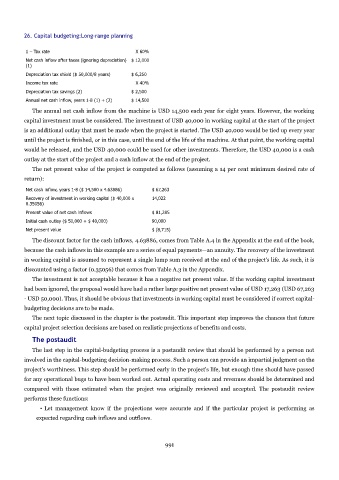Page 990 - Accounting Principles (A Business Perspective)
P. 990
26. Capital budgeting:Long-range planning
1 – Tax rate X 60%
Net cash inflow after taxes (ignoring depreciation) $ 12,000
(1)
Depreciation tax shield ($ 50,000/8 years) $ 6,250
Income tax rate X 40%
Depreciation tax savings (2) $ 2,500
Annual net cash inflow, years 1-8 (1) + (2) $ 14,500
The annual net cash inflow from the machine is USD 14,500 each year for eight years. However, the working
capital investment must be considered. The investment of USD 40,000 in working capital at the start of the project
is an additional outlay that must be made when the project is started. The USD 40,000 would be tied up every year
until the project is finished, or in this case, until the end of the life of the machine. At that point, the working capital
would be released, and the USD 40,000 could be used for other investments. Therefore, the USD 40,000 is a cash
outlay at the start of the project and a cash inflow at the end of the project.
The net present value of the project is computed as follows (assuming a 14 per cent minimum desired rate of
return):
Net cash inflow, years 1-8 ($ 14,500 x 4.63886) $ 67,263
Recovery of investment in working capital ($ 40,000 x 14,022
0.35056)
Present value of net cash inflows $ 81,285
Initial cash outlay ($ 50,000 + $ 40,000) 90,000
Net present value $ (8,715)
The discount factor for the cash inflows, 4.63886, comes from Table A.4 in the Appendix at the end of the book,
because the cash inflows in this example are a series of equal payments—an annuity. The recovery of the investment
in working capital is assumed to represent a single lump sum received at the end of the project's life. As such, it is
discounted using a factor (0.35056) that comes from Table A.3 in the Appendix.
The investment is not acceptable because it has a negative net present value. If the working capital investment
had been ignored, the proposal would have had a rather large positive net present value of USD 17,263 (USD 67,263
- USD 50,000). Thus, it should be obvious that investments in working capital must be considered if correct capital-
budgeting decisions are to be made.
The next topic discussed in the chapter is the postaudit. This important step improves the chances that future
capital project selection decisions are based on realistic projections of benefits and costs.
The postaudit
The last step in the capital-budgeting process is a postaudit review that should be performed by a person not
involved in the capital-budgeting decision-making process. Such a person can provide an impartial judgment on the
project's worthiness. This step should be performed early in the project's life, but enough time should have passed
for any operational bugs to have been worked out. Actual operating costs and revenues should be determined and
compared with those estimated when the project was originally reviewed and accepted. The postaudit review
performs these functions:
• Let management know if the projections were accurate and if the particular project is performing as
expected regarding cash inflows and outflows.
991

